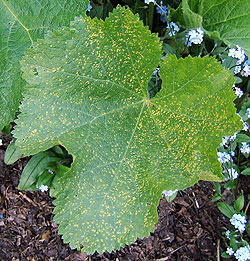|
|
|
|||||
|
|
||||||
|
||||||||||
|
Fast Growing Trees Fastest
Deciduous |
|
Faster
Deciduous |
|
Fast
Deciduous
Evergreen |
|
Fast Growing
Hedging Plants
Deciduous
Evergreen
Arborvitae
Douglas Fir |
|
Other unwelcome visitors: cats | foxes | frogs | moles :: pests and diseases | ants | aphids | blackspot | botrytis - gray mold | caterpillars | Japanese beetle larvae | leatherjackets | mealybugs | powdery mildew | red spider mite | rust | slugs and snails | vine weevils | whitefly |
|
|
Signs - Very descriptive these fungal diseases - looks like the plant is going rusty. Orange-brown pustules develop initially on the undersides of leaves. These may be unnoticed for some time, so by the time the pustules appear on the upper leaf surface and are noticed, the disease has taken hold. Actually a whole group of different fungi can cause the disease known as rust, and different types often have different host preferences and life cycles.
Damage - Not usually a killer, but very unsightly and badly affected plants can be so weakened they are unable to withstand winter frosts.
Treatment - A fungal disease so one of the best ways of dealing with it is by good hygiene. Remove all dead leaves in autumn to prevent the spores from over wintering, burn the leaves or take them to the skip rather than use them for compost or you may well just perpetuate the problem.
Grow resistant varieties. Badly infected plants are best discarded - on the bonfire or tip, not the compost heap - and replaced.
Improve ventilation for plants grown under cover. Keep plants watered and fed well so they are able to fend off the effects of rust with their own immune system.
Hollyhocks will almost always get rust, the best way to deal with it is to grow new plants each year as older plants will just get worse and worse.


Horsetail (Equisetum arvense) is a pernicious
weed which spreads by underground stems that go very deep and form horizontal rhizome
systems. This makes it particularly difficult to control particularly on heavy soils
where trying to pull it up just breaks off the stems leaving a piece in the soil
to carry on. If you have a horsetail problem, there's a bright side to it because
an infusion of the weed makes a good fungicide for control of mildew on strawberries
and other crops, and checks rust on celery and celeriac.
Collect the horsetail, foliage, stems, rhizomes and all, and for each 28g (1oz)
pour on 1.1 Liters (2pt) hot, not boiling, water, and allow to stand for twenty-four
hours. Strain off the 'tea' and use undiluted.
|
|
|
About us. General queries and emails to |
|
Copyright © Paul Ward 2000 - 2012 |